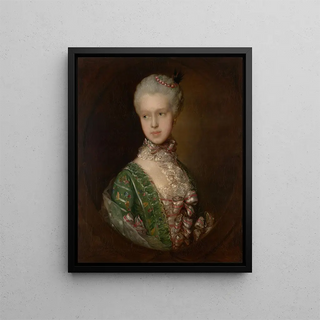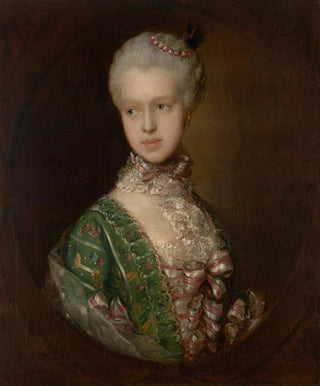Art print | Elizabeth Wrottesley, later Duchess of Grafton - Thomas Gainsborough


View from behind

Frame (optional)
In the fascinating world of 18th-century British painting, the art print "Elizabeth Wrottesley, later Duchess of Grafton" by Thomas Gainsborough stands out for its elegance and psychological depth. This depiction of a high society woman, both majestic and intimate, invites the viewer on a journey through time, revealing not only the beauty of the subject but also the artist's unparalleled skill. Gainsborough, master of the portrait, manages to capture the very essence of his model, transforming her into a symbol of grace and refinement. Through this work, we are transported into the intimacy of English aristocracy, where every detail tells a story.
Style and uniqueness of the work
Gainsborough's art print is characterized by a delicate and sensitive approach to light and color. In this portrait, the soft and nuanced palette creates a serene atmosphere, while the treatment of fabrics reveals meticulous attention to textures. The drapes of Elizabeth Wrottesley's gown are rendered with such virtuosity that they seem almost tangible, adding a tactile dimension to the painting. The duchess's gaze, both direct and dreamy, establishes an immediate connection with the viewer, creating a tension between the physical presence of the subject and her inner world. This duality is one of Gainsborough's signatures, who manages to transcend the simple portrait to offer a reflection on identity and social status of her time.
The artist and his influence
Thomas Gainsborough, born in 1727, is one of the most influential painters of his era, and his work has left an indelible mark on the history of British art. Trained at the school of Flemish painting and influenced by European masters, he developed a style that is uniquely his own, blending realism and romanticism. Gainsborough is distinguished not only by his technique but also by his ability to understand and depict human emotions. His innovative approach to portraiture paved the way for many artists, and his influence is still felt today. In "Elizabeth Wrottesley, later Duchess of G

Matte finish

View from behind

Frame (optional)
In the fascinating world of 18th-century British painting, the art print "Elizabeth Wrottesley, later Duchess of Grafton" by Thomas Gainsborough stands out for its elegance and psychological depth. This depiction of a high society woman, both majestic and intimate, invites the viewer on a journey through time, revealing not only the beauty of the subject but also the artist's unparalleled skill. Gainsborough, master of the portrait, manages to capture the very essence of his model, transforming her into a symbol of grace and refinement. Through this work, we are transported into the intimacy of English aristocracy, where every detail tells a story.
Style and uniqueness of the work
Gainsborough's art print is characterized by a delicate and sensitive approach to light and color. In this portrait, the soft and nuanced palette creates a serene atmosphere, while the treatment of fabrics reveals meticulous attention to textures. The drapes of Elizabeth Wrottesley's gown are rendered with such virtuosity that they seem almost tangible, adding a tactile dimension to the painting. The duchess's gaze, both direct and dreamy, establishes an immediate connection with the viewer, creating a tension between the physical presence of the subject and her inner world. This duality is one of Gainsborough's signatures, who manages to transcend the simple portrait to offer a reflection on identity and social status of her time.
The artist and his influence
Thomas Gainsborough, born in 1727, is one of the most influential painters of his era, and his work has left an indelible mark on the history of British art. Trained at the school of Flemish painting and influenced by European masters, he developed a style that is uniquely his own, blending realism and romanticism. Gainsborough is distinguished not only by his technique but also by his ability to understand and depict human emotions. His innovative approach to portraiture paved the way for many artists, and his influence is still felt today. In "Elizabeth Wrottesley, later Duchess of G






